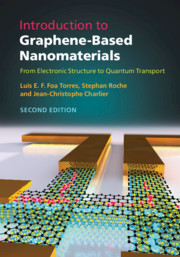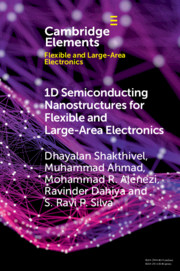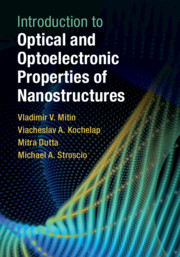Refine listing
Actions for selected content:
881 results in Ebooks in nanotechnology
8 - Spin-Related Phenomena
-
- Book:
- Introduction to Graphene-Based Nanomaterials
- Published online:
- 10 January 2020
- Print publication:
- 30 January 2020, pp 237-277
-
- Chapter
- Export citation
Appendix D - Recursion Methods for Computing the Density of States (DOS) and Wavepacket Dynamics
-
- Book:
- Introduction to Graphene-Based Nanomaterials
- Published online:
- 10 January 2020
- Print publication:
- 30 January 2020, pp 401-412
-
- Chapter
- Export citation
Preface to the Second Edition
-
- Book:
- Introduction to Graphene-Based Nanomaterials
- Published online:
- 10 January 2020
- Print publication:
- 30 January 2020, pp xi-xii
-
- Chapter
- Export citation

Introduction to Graphene-Based Nanomaterials
- From Electronic Structure to Quantum Transport
-
- Published online:
- 10 January 2020
- Print publication:
- 30 January 2020

1D Semiconducting Nanostructures for Flexible and Large-Area Electronics
- Growth Mechanisms and Suitability
-
- Published online:
- 21 October 2019
- Print publication:
- 31 October 2019
-
- Element
- Export citation

Introduction to Optical and Optoelectronic Properties of Nanostructures
-
- Published online:
- 25 March 2019
- Print publication:
- 21 March 2019
Appendix B - Tables of Units
-
- Book:
- Introduction to Optical and Optoelectronic Properties of Nanostructures
- Published online:
- 25 March 2019
- Print publication:
- 21 March 2019, pp 386-388
-
- Chapter
- Export citation
Preface
-
- Book:
- Introduction to Optical and Optoelectronic Properties of Nanostructures
- Published online:
- 25 March 2019
- Print publication:
- 21 March 2019, pp ix-xii
-
- Chapter
- Export citation
Appendix C - List of Pertinent Symbols
-
- Book:
- Introduction to Optical and Optoelectronic Properties of Nanostructures
- Published online:
- 25 March 2019
- Print publication:
- 21 March 2019, pp 389-390
-
- Chapter
- Export citation
7 - Light-Emitting Devices Based on Interband Phototransitions in Quantum Structures
-
- Book:
- Introduction to Optical and Optoelectronic Properties of Nanostructures
- Published online:
- 25 March 2019
- Print publication:
- 21 March 2019, pp 260-330
-
- Chapter
- Export citation
6 - Electro-Optics and Nonlinear Optics
-
- Book:
- Introduction to Optical and Optoelectronic Properties of Nanostructures
- Published online:
- 25 March 2019
- Print publication:
- 21 March 2019, pp 211-259
-
- Chapter
- Export citation
5 - Optics of Quantum Structures
-
- Book:
- Introduction to Optical and Optoelectronic Properties of Nanostructures
- Published online:
- 25 March 2019
- Print publication:
- 21 March 2019, pp 168-210
-
- Chapter
- Export citation
2 - Materials for Optoelectronic Applications
-
- Book:
- Introduction to Optical and Optoelectronic Properties of Nanostructures
- Published online:
- 25 March 2019
- Print publication:
- 21 March 2019, pp 9-59
-
- Chapter
- Export citation
4 - Light–Semiconductor Materials Interaction
-
- Book:
- Introduction to Optical and Optoelectronic Properties of Nanostructures
- Published online:
- 25 March 2019
- Print publication:
- 21 March 2019, pp 125-167
-
- Chapter
- Export citation
Index
-
- Book:
- Introduction to Optical and Optoelectronic Properties of Nanostructures
- Published online:
- 25 March 2019
- Print publication:
- 21 March 2019, pp 401-404
-
- Chapter
- Export citation
Appendix A - Basic Statements and Formulae of Quantum Physics
-
- Book:
- Introduction to Optical and Optoelectronic Properties of Nanostructures
- Published online:
- 25 March 2019
- Print publication:
- 21 March 2019, pp 373-385
-
- Chapter
- Export citation
8 - Devices Based on Intraband Phototransitions in Quantum Structures and Silicon Optoelectronics
-
- Book:
- Introduction to Optical and Optoelectronic Properties of Nanostructures
- Published online:
- 25 March 2019
- Print publication:
- 21 March 2019, pp 331-372
-
- Chapter
- Export citation
Frontmatter
-
- Book:
- Introduction to Optical and Optoelectronic Properties of Nanostructures
- Published online:
- 25 March 2019
- Print publication:
- 21 March 2019, pp i-iv
-
- Chapter
- Export citation
Further Reading
-
- Book:
- Introduction to Optical and Optoelectronic Properties of Nanostructures
- Published online:
- 25 March 2019
- Print publication:
- 21 March 2019, pp 391-400
-
- Chapter
- Export citation
1 - Some Trends in Optoelectronics
-
- Book:
- Introduction to Optical and Optoelectronic Properties of Nanostructures
- Published online:
- 25 March 2019
- Print publication:
- 21 March 2019, pp 1-8
-
- Chapter
- Export citation
